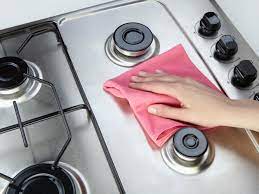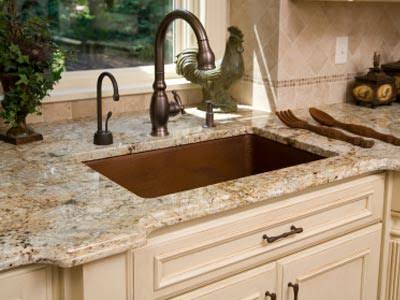The pH level of your pool affects every other chemical balance in pool water. pH is a measure of the level of hydrogen ions or acidity of the pool water. Measured on a logarithmic scale, a pH of 0 indicates extremely acidic conditions, and a pH of 14 indicates extremely basic conditions. A pH of 7 is neutral.
Always wear acid resistant gloves, long pants and eye protection when handling pool acid.
The most desired pH of pool water is between 7.2 to 7.6, slightly basic. This is the most comfortable range for your eyes and skin, and provides the optimum chlorine levels to prevent bacteria, algae and fungus growth, without developing scale, the white crusty substance often seen on pool tiles, or becoming too corrosive. Hydrochloric acid is often used to adjust pool water back towards this optimum range when it has become too basic.
Test pH weekly. The recommended range is between 7.2 and 7.6. If the pH is higher than 7.6, correct it by adding the Hydrochloric (Muriatic) Acid 10% as shown on the following table:
Never add Hydrochloric Acid when people are in the pool.
|
Approximate amounts of Hydrochloric (Muraitic) Acid 9% - 10% used when the pH is high. |
||||
|
Volume of Pool Water (Lt) |
Below 7.2 |
pH Grading 7.2 – 7.6 |
8.0 |
8.4 |
|
10,000 |
Do Not Use Acid |
Recommended Range |
350 ml |
420 ml |
|
30,000 |
1 L |
1.2 L |
||
|
50,000 |
1.7 L |
2 L |
||
|
100,000 |
3.5 L |
4 L |
||
DO NOT ADD MORE THAN 500ML AT ANY ONE TIME
Note:
This depends on just how high the pH is and the size of the pool. The amount calculations are not exact. It is always best to add less than the full amount, wait a little while to allow the addition to mix thoroughly, and then retest to see where you are. If you have a smaller pool, or an above-ground pool, you would start with one cup of acid, and then re-test and add more if needed.
What is pH?
pH is a measure of how acidic or alkaline the water is. The pH scale ranges from 0 to 14, with 7 being neutral. Values below 7 are acidic and values above 7 are alkaline. With pool water we are seeking a pH balance suitable to the pool users, the pool and the sanitiser used. The operating range as 7.0 to 7.8, ( 7.0 to 7.2 for fiberglass pools and 7.4 to 7.8 for concrete pools). Topping up your pool, heavy rain, heavy bathing loads and chemical additions can all change the pH level of your pool water. pH must be kept within the operating range because if it is too high or too low it may:
- Create swimmer discomfort (itchy skin, red eyes etc.)
- Interfere with the sterilising action of your pool sanitiser.
- Cause damage to the pool surface.
- Damage the pool equipment
pH is one of the most important aspects of your pool maintenance program.
General Instructions
- When adding Hydrochloric (Muriatic) Acid ensure that the product is mixed thoroughly with water remembering to always add acid to water, never add water to acid.
- Apply the mixed chemical to the surface of the pool water.
- Allow 2-3 hours mixing with the filter running before measuring pH again. Carry out minor adjustments as necessary.
- Store in an upright and secure position in a cool, well ventilated place. Keep out of reach of children.
- Make sure you read all the instructions on the label.
Tips on Lowering your Swimming Pool pH
- Never pour any chemicals into your skimmer filter basket (if you have one). The water here goes directly to your expensive pool pump, filter, heater, and other equipment.
- If pH is really low, test strips and even test kits cannot test higher than a pH of 8.6. If this is the case, you will need to add a significant amount of pH reducer or muriatic acid to bring that pH value back down to testable levels. Once you can test pH, then you can fine tune how much more you need to reduce the pH.
TIPS & WARNING:
- Muriatic acid is caustic. If you get it on your skin it will burn. Wear goggles, gloves, long sleeve shirt, and heavy jeans. Have a bucket of water and a hose with a sprayer attached with the water already turned on, ready to hose yourself or anything else off if you spill.If you do manage to dump it on yourself, wash it off immediately.
- Do not spill muriatic acid on any concrete, tile, or any other masonry. I cannot stress this enough. If any of you have sealed your garage floor with epoxy based floor covering, a recommended step prior to applying the epoxy is to apply undiluted muriatic acid to the garage floor. This etches the concrete so the epoxy will stick, giving off bluish green fumes that rise off the concrete, plus some bubbling and fizzing that also occurs.
- When working with muriatic acid over concrete, you can try to pre-wet the concrete with water to help with diluting any potential spills or drops that might end up on the concrete.
- You typically want to dilute the muriatic acid in a bucket of water to prevent burning yourself, pool surfaces, or equipment. Habitat muriatic acid containers come pre-diluted so you don’t have to mix with water and you can just apply directly to the pool.
- Although it may seem crazy to put such a damaging liquid into your swimming pool water, even strong acids like this one are beneficial in small doses.




1 comment
Margo
This was so easy to read and understand for those trying to maintain the balance.Thanks
This was so easy to read and understand for those trying to maintain the balance.Thanks